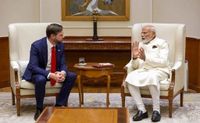On April 22, 2025, U.S. Vice President James David Vance announced that the United States and India have finalized the terms of reference for a significant trade negotiation, aiming to double bilateral trade to an impressive $500 billion by the end of the decade. This announcement came during a notable address at the India-U.S. Forum in Jaipur, India, where Vance articulated a bold vision for deepening ties between the two nations.
The potential trade deal represents a crucial step towards fulfilling the ambitious goals set by President Donald Trump and Indian Prime Minister Narendra Modi earlier this year. Vance expressed optimism about the future, stating, "I believe there is much that America and India can accomplish together." He emphasized that the trade agreement is not just about numbers but about building a partnership based on fairness and shared national interests.
In his address, Vance outlined three key areas of cooperation that the trade deal will focus on: defense, energy, and technology. The U.S.-India Compact aims to enhance the defense relationship through the co-production of military equipment, including the proposed American F-35 jets, which are intended to strengthen India’s air defenses. Vance noted, "India and the U.S. will co-produce many defense equipment items," highlighting the strategic importance of military collaboration between the two countries.
On the energy front, Vance discussed the potential benefits for India from expanded American oil and gas production. He urged India to lower non-tariff barriers to American energy products, stating, "We want India to buy more of our military equipment," and emphasizing the need for a cooperative approach to energy security. Vance also expressed his belief that America’s energy resources could help India realize its nuclear goals, welcoming India's recent budget amendment of nuclear liability laws.
The technology sector is another vital area where Vance sees immense potential for collaboration. He praised the U.S.-India Trust Initiative as a foundation for future partnerships, suggesting that there could be significant synergies between India's vibrant startup ecosystem and America's prowess in artificial intelligence hardware.
However, the proposed trade deal has not been without its controversies. The All India Kisan Sabha, or the All India Farmers Union, has voiced concerns that the agreement could threaten the livelihoods of Indian farmers. This apprehension reflects broader anxieties about how increased trade and economic integration might impact local industries and agricultural sectors.
Vance's announcement follows a personal trip to India, during which he met with Prime Minister Modi to discuss trade and cooperation. Their discussions were aimed at easing the trade tensions that have arisen from Trump's tariff policies, which had previously imposed a 26% reciprocal tariff on India. Although these tariffs were suspended for 90 days, the lingering effects have raised questions about the future of U.S.-India trade relations.
In a broader context, Vance emphasized the historical significance of the moment, stating, "If India and the U.S. fail to work together, the 21st century will be a dark time for the world." His remarks underscore the critical nature of the partnership between the two nations, particularly in an era marked by global economic uncertainties and geopolitical rivalries.
The announcement has been met with mixed reactions. While it provides a sense of optimism for exporters and businesses reliant on the U.S. market, the Indian Rupee (INR) continues its corrective decline against the U.S. Dollar (USD). As of the latest trading, the USD/INR is marginally higher at 85.19, indicating ongoing market volatility.
Vance’s speech also served as a reminder of the administration’s commitment to seeking trade partners based on fairness and mutual respect. He stated, "Our administration seeks trade partners on the basis of fairness. We have common goals with India," reiterating the need for bilateral cooperation that respects the value of labor and promotes equitable economic growth.
As the U.S. prepares for the presidential election in November 2024, trade remains a pivotal issue. Trump has made it clear that he intends to use tariffs strategically to bolster the U.S. economy and support American producers. In 2024, significant U.S. imports came from Mexico, China, and Canada, which together accounted for 42% of total imports. Vance's remarks signal a potential shift in focus towards strengthening ties with India as part of a broader strategy to enhance U.S. trade relations.
In conclusion, the finalized terms of reference for the trade negotiation between the U.S. and India mark a significant milestone in the evolving relationship between the two nations. With a focus on defense, energy, and technology, the potential deal aims to create new jobs and build resilient supply chains. As both countries navigate the complexities of global trade, the success of this partnership will depend on their ability to address concerns and foster a collaborative environment that benefits workers and industries in both nations.









